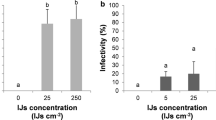Abstract
Entomopathogenic nematodes Steinernema carpocapsae were applied in a chitosan formulation (Biorend R®) to control the flat-headed rootborer Capnodis tenebrionis (Coleoptera: Buprestidae) in 5 field trials in the province of Valencia, Spain. Application was performed during spring and summer into the soil around apricot trees at densities of 1 and 1.5 million infective dauer juveniles per tree through drip irrigation, injection or by a drench. For evaluation of the control effect the roots of 106 trees were excavated, the cortex removed and living and dead insects were sampled. Dead larvae were dissected and checked for nematode infestation. Control of C. tenebrionis larvae was between 75% and 90%. No influence of the application method, nematode density or time of application on the control effect was recorded. Recovery of the infested trees was observed already in the season following nematode application. Due to the two year life cycle of the insect with egg laying from May to August, applications during spring and autumn are recommended.



Similar content being viewed by others
References
Ait Barka E, Eullaffroy P, Clement C, Vernet G (2004) Chitosan improves development and protects Vitis vinifera L. against Botrytis cinerea. Plant Cell Rep 22:608–614
Alekseev E, Glazer I, Samish M (2006) Effect of soil texture and moisture on the activity of entomopathogenic nematodes against female Boophilus annalatus ticks. BioControl 51:419–438
Ben-Yehuda S, Assael F, Mendel Z (2000) Improved chemical control of Capnodis tenebrionis and C. carbonaria in stone fruit plantations in Israel. Phytoparasitica 28:27–41
Britvec B (2002) The biome and scientific investigations in Croatia. Entomologia Croatica 6:75–96
Chrestian P (1955) Le Capnode noir des Rossacées. Protectorat de la République Française au Maroc, Service de la Défence des Végétaux Rabat. Travaux originaux 6 141 pp
Colasurdo G, Vallillo E, Berchicci D, Romualdi G, de Lillo E (1997) Prime esperienze di controllo degli adulti di Capnodis tenebrionis in Molise. Inf Fitopatol 10:53–57
Ehlers RU, Lunau S, Krasomil-Osterfeld K, Osterfeld K-H (1998) Liquid culture of the entomopathogenic nematode-bacterium-complex Heterorhabditis megidis/Photorhabdus luminescens. BioControl 43:77–86
Ehlers RU (2001) Mass production of entomopathogenic nematodes for plant protection. Appl Microbiol Biotechnol 56:623–633
Ehlers RU (2003) Biocontrol nematodes. In: Hokkanen HMT, Hajek AE (eds) Environmental impacts of microbial insecticides. Kluwer Acedemic Publisher, Dordrecht, NL, (pp 177–220)
Ferrero F (1987) Trois bupresten ennemies de l’abricotier en Roussillon. Phytoma 384:43
García MT, Perez JA, Arias A, Martinez de Velasco D (1996) Adult population and period of oviposition of Capnodis tenebrionis (L.) (Col.: Buprestidae) in cherry orchards in the Jerte valley. Bol Sanid Veg, Plagas 22:451–463
García del Pino F, Morton A (2005) Efficacy of entomopathogenic nematodes against neonate larvae of Capnodis tenebrionis (L.) (Coleoptera: Buprestidae) in laboratory trials. BioControl 50:307–316
Garrido A (1984) Bioecology of Capnodis tenebrionis L. (Coleop.: Buprestidae) and approaches to its control. Boletin del Servicio de Defensa contra Plagas e Inspeccion Fitopatologica 10:205–221
Garrido A, Malagon J, Busto T del (1990) Toxicity of pesticides by contact and ingestion against adults of Capnodis tenebrionis (L.), (Coleoptera: Buprestidae). Bol Sanid Veg, Plagas 16:165–172
Grewal PS, Ehlers R-U, Shapiro-Ilan DI (eds) (2005) Nematodes as biocontrol agents. CABI Publisher, Wallingford, UK
Hadwiger LA, Loschke DC (1981) Molecular communication in host-parasite interactions: Hexosamine polymers chitosan as regulator compounds in race specific and other interactions. Phytopathology 71:756–762
Hmimina M, Sekkat A, Lahfa L, Histane M (1988) Biological cycle of Capnodis tenebrionis L. (Coleoptera, Buprestidae) in the region of Meknes. Actes de l’Institut Agronomique et Vétérinaire Hassan II 8:41–49
Koppenhofer AM, Baur ME, Stock SP, Ho YC, Chinnasri B, Kaya HK (1997) Survival of entomopathogenic nematodes within host cadavers in dry soil. Appl Soil Ecol 6:231–240
Lobatón CS, Vela JRG, Lopez MPL, Roca AC (1998) Bioassays with a strain of Steinernema carpocapsae (Filipjev) detected on Capnodis tenebrionis L. larvae. Bol Sanid Veg, Plagas 24:679–686
Marannino P, Tarasco E, De Lillo E (2003) Biological notes on larval hatching in Capnodis tenebrionis (L.) (Coleoptera Buprestidae) and evaluation of entomopathogenic nematodes in controlling neonate larvae. Redia 86:101–105
Mahhou A, Dennis FG Jr (1992) The almond in Morocco. Horticulture Technology 2:488–492
Martin H (1951) Contribution à l’étude du Capnode noir des arbres fruitiers (Capnodis tenebrionis L.) dans la région d’Alger. Revue de Pathologie Végétale et d’Entomologie Agricole 30:97–113
Martinez Peña A (2002) Biological pesticide based on chitosan and entomopathogenic nematodes. WO Patent 037966
Mendel Z, Assael F, Ben Yehuda S (2003) Host selection and root colonization of cyanogenic stonefruit species by Capnodis spp. (Coleoptera: Buprestidae). Ann Entomol Soc Am 96:127–134
Rivnay E (1944) Physiological and ecological studies on the species of Capnodis in Palestine (Col., Buprestidae). I. Studies on the eggs. Bull Entomol Res 33:235–242
Sanchez-Capuchino JA, Garcia S, Salazar DM, Miro M, Martinez R, Melgarejo P (1987) El almedro como patròn en secano del albaricoquero frente al ataque dal gusano cabezudo. Agricola Vergel 62:80–84
Sanna Passino G, Delrio G (2001) Efficacy of insecticides on larvae of Capnodis tenebrionis (L.). Bol Sanid Veg, Plagas 27:59–64
Ulusoy MR, Vatansever G, Uygun N (1999) The cherry pests, their natural enemies and observations on some important species in Uluksla (Nigde) and Pozant (Adana) province of Turkey. Turkiye Entomoloji Dergisi 23:111–120
Viggiani G (1991) Pests of apricots. Acta Horticulturae 2:481–486
Acknowledgement
Thanks are due to the EU COST Action 850 “Biocontrol Symbiosis” for the support of a travel grant of the first author to the University Kiel, Germany.
Author information
Authors and Affiliations
Corresponding author
Rights and permissions
About this article
Cite this article
Martinez de Altube, M.M., Strauch, O., Fernandez De Castro, G. et al. Control of the flat-headed root borer Capnodis tenebrionis (Linné) (Coleoptera: Buprestidae) with the entomopathogenic nematode Steinernema carpocapsae (Weiser) (Nematoda: Steinernematidae) in a chitosan formulation in apricot orchards. BioControl 53, 531–539 (2008). https://doi.org/10.1007/s10526-007-9094-0
Received:
Accepted:
Published:
Issue Date:
DOI: https://doi.org/10.1007/s10526-007-9094-0




